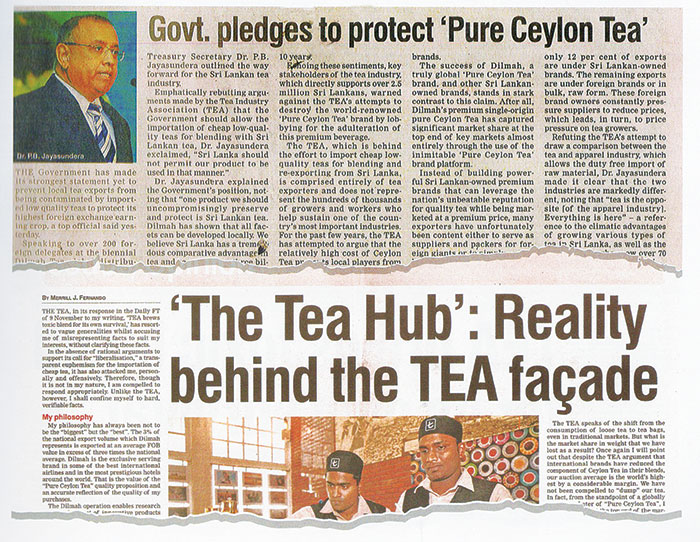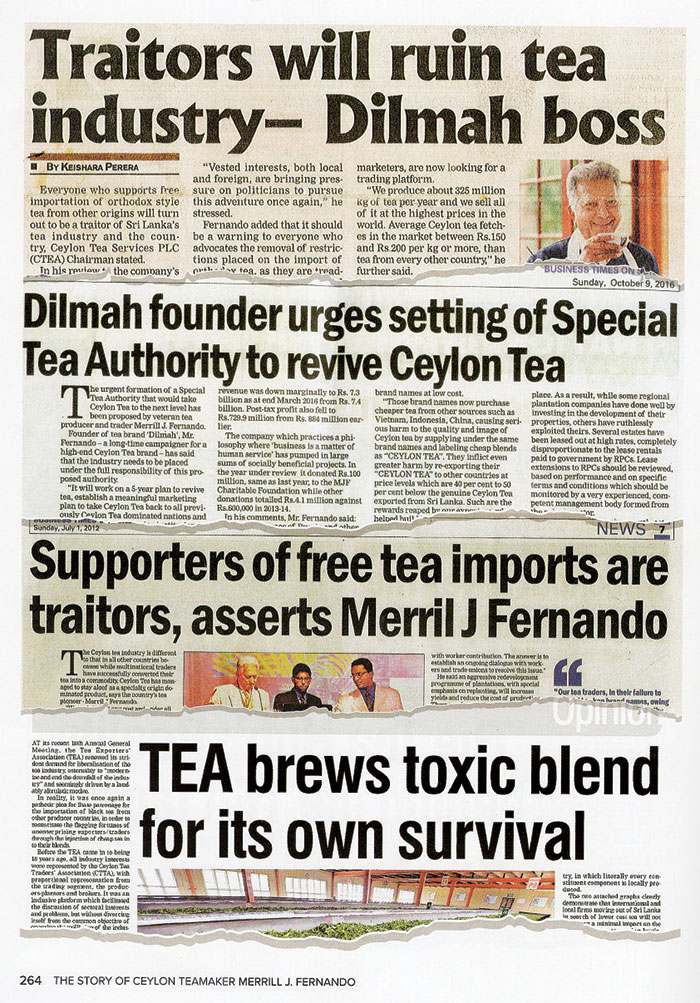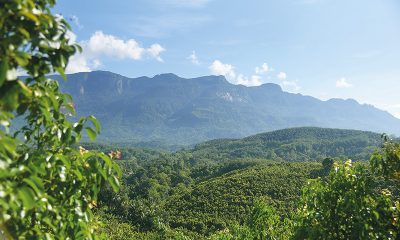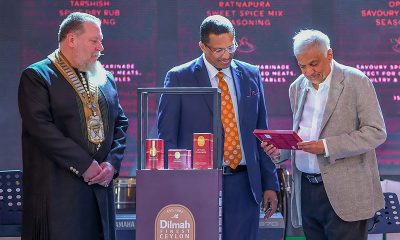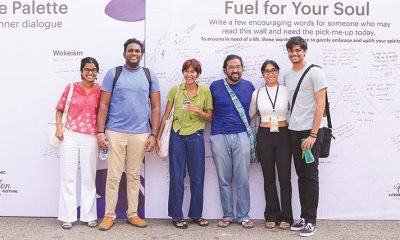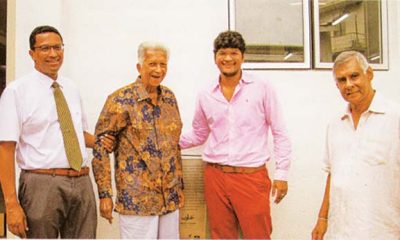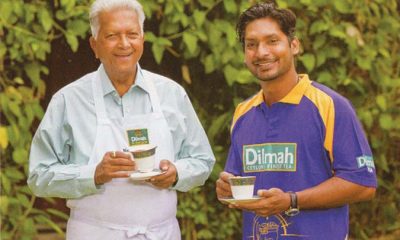Features
My continuing battle against the Tea Hub proposal that would have debased pure Ceylon Tea
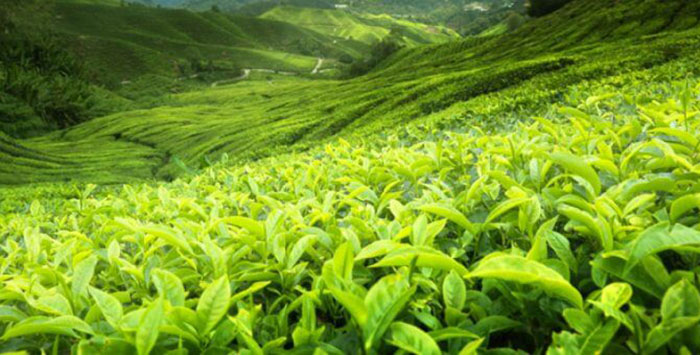
Multinationals have long reduced the content of Ceylon tea in packs branded as such
(Excerpted from the autobiography of Merrill J. Fernando)
The ruthless philosophy of the multinational packer and retail supplier is to buy low and sell high in mass markets in which the consumer, through relentless advertising and promotion, has been compelled to accept a well-packaged mediocrity masquerading as excellence. The intrinsic value of a product such as Pure Ceylon Tea and its inherent value proposition is subordinated to profit. Concepts such as genuine product purity and uniqueness of origin have no place in such a world. Such values do not belong in the base culture of mass-marketing of bland, homogeneous products.
The importation of cheap tea from multiple origins would immediately result in the discounting, at the Colombo Auction, of equivalent grades produced in this country, which would invariably be of a higher value than the import. In fact, the cost of any cheap imported tea would be well below our national cost of production, which, for a number of well known reasons, is the highest in the world.
A glut of such low-priced imported tea would depress auction prices overall and adversely impact the grower and producer, who are already burdened by high production costs and diminishing land and worker productivity. In the meantime, the cheap blend, with its desirability enhanced by the legend ‘packed in Sri Lanka/Ceylon,’ will be perceived as genuine Ceylon Tea by the overseas consumer. That perception will cause irreparable damage to the image of Pure Ceylon Tea and, also, to the exporter of the genuine product.
Despite the many abuses it has been subject to over the years, at the hands of multinationals and other traders, who have no respect for either purity or origins, Ceylon Tea is not a commodity as other teas are. Pure Ceylon Tea, of itself and in itself, is a brand and a specialty in the eyes of the consumer. There is no other tea in the world which is recognized internationally by the country of its origin like Ceylon Tea; nor is any other country globally identified by the tea it produces like Sri Lanka/Ceylon.
Up to about 20 years ago, Ceylon Tea was promoted and marketed on that unique value proposition and that memory still lingers in the minds of the older, middle-aged consumer. It was that memory of quality which ensured the success of Dilmah in Australia, despite it being priced well above its competing brands produced by the big multinationals.
Historically, though, commoditization has been the strategy of the trader, the promotion of the brand on the strength of the quality image of Ceylon Tea and then gradually reducing the latter component, thus deluding the overseas consumer and impoverishing the local farmer. Consumers who purchase blindly on brand loyalty do not perceive the gradual erosion in the quality of the cup of tea they drink every day. They will continue to patronize the debased product as a conditioned reflex to compelling advertising and promotion.
A recent example of the strategy described above is the fate of the Russian market, first serviced by our own traders, who, instead of developing own labels when the opportunity arose, chose the easy path and became servitors of the foreign label. The end result was an ignominious exit from the market when the Russian buyer, having established market share on the strength of Ceylon Tea, took his business elsewhere or established his own packing plants in Russia itself.
Value addition, branding, and marketing have, for long, been the weakest features in our export field. Despite all their arguments to the contrary, increasing the total value of our exports using cheap imported tea is not practically possible. The immediate result would be the decline of the export price of Pure Ceylon Tea.
Value-added tea is already being exported at prices ranging from Rs. 600 per kg to Rs. 1,100 per kg. The availability of Ceylon Tea at those prices, automatically weakens the argument for importation of cheap tea, unless the purpose is simply to devalue the export price.
It is also most unlikely that global players in the tea trade, packing in-market, using cheap, multi-origin tea, would rush to Sri Lanka to establish packing centres with the establishment of a Tea Hub. We are far removed from the main markets of the global packers and the only inducements for them to set up operations in Sri Lanka would be the availability of low-cost labour and cheap tea, at rock-bottom prices, the margin savings overriding other disadvantages, such as additional shipping and distribution costs. Such operators will not buy the high-priced Ceylon Tea, unless the proposed massive influx of imported tea drives the local auction prices down to the floor! Is it necessary to emphasize that such a scenario would be the death knell for the local producer?
Unacceptable comparisons, Garment Sector vs. Tea Export Industry
Blending hubs such as Dubai and Rotterdam, examples frequently used by the Tea Hub proponents as ideal models for replication, cannot be equated with Sri Lanka, which is a major producer. Such hubs are commercial centers which facilitate the recycling of products from multiple origins and owe no allegiance to producing countries.
As for the much-touted increase in employment generated by a Tea Hub, it is a myth, as any new blending or packing plant would be fully automated and designed specifically to minimize manual labour. In an industrialized world relentlessly driving towards robotization of processes, manpower is the first designated casualty in any new venture.
The loss of traditional markets for our tea has not been due to price concerns, but largely due to our inadequacies in value addition, marketing, and promotion. The emergence of ‘Dilmah’ as a premier product in Australia and New Zealand, despite being much higher in price than the corresponding products from large multinationals, is proof of the effectiveness of product promotion on the intrinsic strengths of the product itself. It completely negates the argument that multi-origin, cheap blends will override the uniqueness of Pure Ceylon Tea on cost alone.
Our tea has for long been acclaimed as the ‘cleanest tea in the world,’ meeting the Minimum Residue Levels (MRL) stipulated by some of the most demanding markets in the world, such as Japan. The importation of cheap tea from multiple origins, of unregulated hygiene and cleanliness standards, would immediately defile that image irrevocably.
The garment sector in Sri Lanka and the establishment of special Free Trade Zones (FTZs) have been quoted by the TEA (Tea Export Association) as successful examples of special manufacturing enclaves, equivalent to the proposed Tea Hub. In my view those are most inappropriate comparisons, as unacceptable as a ‘chalk and cheese’ equivalent.
The apparel industry exists almost entirely for the servicing of foreign labels, with 95% of the components being imported, whilst, locally, we simply supply the labor. It is. essentially, a massive labor- intensive operation, dedicated to the concept of maximum production at the lowest cost, but embellished with attractive labels, supported by cutting-edge technology, best manufacturing practices, and compliance with international standards, process hygiene and worker safety.
I am not, even for one moment, belittling the success of the garment industry in Sri Lanka, but those are the realities. Sri Lankans do not own the garment industry and are almost entirely dependent on foreign label patronage for continued existence. In that respect alone, the garment industry in Sri Lanka is very similar to the foreign label service provided by Sri Lankan traders to multi-national tea packers. The establishment of a Tea Hub will relegate our tea industry to that unattractive niche. As long as we are in control of the production of the raw material, we have the power to strategize how and where we sell it and at what price.
The establishment of FTZs was to ensure that the finished product, or the raw material, is not leaked out to local markets. As opposed to that, in the plantation industry, possibly over 95% of the raw material and other components are generated locally. It is a totally home-grown industry where the raw material, in its totality, is produced within.
There are only two sustainable ways of increasing the export value of our tea. One is to improve our land and labour productivity and increase annual production and, thus, send more tea to the auction annually. Another is to increase value addition at source to locally-owned brands, thus enhancing the export price. In fact, simply increasing production without a parallel strategy for adding value is also counterproductive.
Auction prices are determined by supply/ demand dynamics which are outside the producers’ area of control and a combination of both volume and quality will not ensure a sustainable revenue increase. Finally, value addition at source to a good quality finished product, namely ‘Pure Ceylon Tea,’ is the surest method of increasing earnings.
Every kilo of tea produced in Ceylon sells at premium prices and, irrespective of other market dynamics, is still considered as a benchmark for overall quality. In such a scenario, the only objective of devaluing it would be for personal gain, in order to compete with the mass-selling, low-priced, multinational trader.
Example of exploitation
The multinational traders’ exploitative strategy in regard to third world products is best illustrated by coffee, grown in countries such as Brazil, Vietnam, Colombia, Ethiopia, Uganda, and many other countries in Africa. In all the countries where coffee is grown in volume, the per capita income of the farmer is a fraction of that of an average farmer in a developed country and miniscule in comparison to the earnings of the average coffee consumer in the West.
Colvin R. de Silva, as Minister of Plantations, was one of the first politicians to publicly and unequivocally articulate this unacceptable disparity. For every plastic cup of coffee sold for USD 3-4 in affluent societies, the farmer in Africa gets five cents. From a kilogramme of coffee sold at USD 2.75, 110 cups can be brewed, translating to a profit margin of over USD 300 for those in between the poor farmer and the rich consumer.
The story of the tea trade in the hands of the multinational tea trader is no different and the cheapening of Ceylon Tea by importing, blending, and re-exporting will contribute further to that unacceptable social and economic disequilibrium.
It is a cardinal rule of all major packers – multinationals – never to purchase their material from one source or origin. Invariably they operate through two or more suppliers. However, because of the excellent and longstanding quality proposition of Ceylon Tea and the confidence we inspired in all the buyers of the major retailers, for many decades Ceylon Tea used to be, if not the major component, the most important ingredient of multinational packs.
Disappointing indications
During a previous Government’s term, the then Finance Minister, Ravi Karunanayake, deluded by the facile arguments of the Tea Hub proponents, facilitated the importation of tea in one of his budgets.
However, my protests against this provision, supported by the then Minister, Ranil Wickremesinghe, resulted in its removal.
I must also admit to being disappointed by the stance of the Planters’ Association, in regard to the issue of the Tea Hub. I recall a strongly-worded press statement (Daily FT, May 17, 2012), in which the PA declared its opposition to the concept. However, as the umbrella body which primarily represents producer interests, I would have expected it to come out far more strongly, vocally, and actively, against an initiative with the very obvious potential to cause serious damage producer.
Sometime in March 2012, immediately after a meeting of the anvil, chaired by me, certain members of the Tea Council met then Plantations Minister, Mahinda Samarasinghe, and advised him that they would boycott future meetings of the Council chaired by me if I continued to oppose the TEA proposals regarding importation of tea. However, they did not breathe a word about this matter at the meeting itself, though that was the most obvious forum for the issue to have been discussed.
Frankly, I was disgusted by the base conduct of those exporters and, by my letter of March 30, 2012, addressed to Minister Samarasinghe, I resigned from the chairmanship of the Council. In my letter I also clearly stated the reasons for my resignation. The Minister accepted it and appointed Tyeab Akberally, Vice Chairman, to the position I relinquished.
The Tea Council was set up in 1989, under the direction of the then Minister of Plantations, Gamini Dissanayake. Its core purpose was resolving the many problems of the entire industry, in a manner that would benefit the industry in its totality; the plantation worker, the producer, the broker, and the exporter, all included. The very submission of a proposal which only addressed the interests of the exporter, to the obvious detriment of all other stakeholders, was in conflict with the remit of the Council.
Dr. P. B. Jayasundera, then Secretary to the Treasury, has always been a strong opponent of the Tea Hub concept. Addressing the CTTA’s 118th Annual General Meeting in late 2012, ironically flanked at the head table by a couple of ardent proponents of the Tea Hub concept, Dr. Jayasundera stated quite unequivocally that the only manner in which the export earnings from tea could be increased was by “creating a new development framework and promoting Ceylon Tea at a premium, setting aside the idea of making the country a Tea Hub”.
Basically, what Dr. Jayasundera supported was to position Sri Lanka as an exclusive centre for value addition to Pure Ceylon Tea and not to convert it to a trading platform for tea from any and every origin.
Bleak certainties
To any impartial observer, it would be clear that the TEA call for liberalization of imports was driven by the sense of insecurity, generated by the rapidly-diminishing profit margins of the proponents. It is a proposal which reflects, with embarrassing clarity, the mindset of the timid exporter and his submission to foreign label pressure. In my many arguments against the Hub, I have frequently requested its supporters to take a moment to consider why a few exporters from Sri Lanka sell comfortably at USD 10 FOB per kilo, whilst others scramble at the bottom, selling at USD 3 per kilo.
All the multinationals operating in Sri Lanka are now manned entirely by Sri Lankans and the industry’s reliance on the former to market our tea should be minimal. However, I am both baffled and saddened by the still very evident orientation and adherence within the industry to archaic multinational thinking and strategy.
In their hunger for short-term gain, the proponents of the Tea Hub are prepared to sacrifice the long-term potential of Pure Ceylon Tea, as well as consign the hundreds of thousands of low-income earners at the producers’ end to permanent impoverishment. In their pursuit of immediate and short term survival, they are prepared to surrender every natural advantage in ‘Pure Ceylon Tea’. The reality is that it is the locally-owned brands exporting exclusively ‘Pure Ceylon Tea,’ which are the flag bearers of the national product on the global stage.
In total, about 12% of this country’s population is dependent, either directly or indirectly, on the plantation economy. Of that proportion, about 90% toil at the producers’ end; plantation workers and residents, small-holders, their dependents, ancillary service suppliers, bought leaf manufacturers, and so on. A decline in the Colombo tea prices, arising from cheap imports, would result in a permanent adverse impact on the lives of this multitude, whilst temporarily enriching a minuscule proportion at the exporters’ end.
Pure Ceylon Tea was, and still is, this country’s greatest asset. It’s a primary home-grown product and identifies Ceylon/Sri Lanka globally. Its real value and significance have either been misinterpreted by successive governments, and many of our local traders, but fully exploited by the multinational who understood its actual worth. Through Ceylon Tea, the country has a product which can stand alone and compete successfully against any tea grown or manufactured in any other country. The maximization of its inherent value proposition simply requires vision, dedication, and integrity of purpose.
For over a century we have permitted Ceylon Tea, a valuable and attractive ‘finished product’ with enormous potential to this country, to be exported by multinational companies to other countries as a ‘raw material’. The importing countries debase its natural quality by blending with inferior tea from other origins, whilst reducing its cost and, with pretty packaging, claim to add value to a less-than-mediocre mix, but still sell it on its intrinsic value as Ceylon Tea. In the process, the tea that is grown by the farmer in our country enriches a chain which has no real link to his country, at the expense of our producer, our farmer, and our plantation worker.
What the proponents of the Tea Hub are advocating so strongly is the replication of the same odious process, in the country of the orign of Ceylon Tea, though they have clothed the proposal in noble rhetoric, as a panacea for all the ills of the tea industry.
Pure Ceylon Tea is still synonymous with quality in the many countries in which it has been a traditional brew, despite the debasement it has suffered at the hands of multinationals who, whilst devaluing its intrinsic goodness, still leveraged the original quality perception in their marketing. Thus, packers determine the quality that they offer the consumer, as the purchasing choice of the latter is limited to what is available on the supermarket shelf.
This compulsion created by the multi-national marketer appears to have created an illusory perception in the minds of certain exporters, especially the Tea Hub proponents, that the cheap, debased tea is actually a consumer demand or preference. Dilmah, however, convincingly exploded this myth with its success in the marketing of quality ‘Pure Ceylon Tea’ in Australia and New Zealand.
Marshalling the opposition
At the beginning of this chapter I referred to the proposal by the then Trade Minister, Lalith Athulathmudali, in 1979, which, to the best of my knowledge, was the first instance when a leading politician presented tea importation as a strategy with potential for economic benefit to the country. To the best of my recollection, there had been no serious discussion about it before, although I am certain that the idea would have been tossed around in tea trading circles. It is really in the 1980s that wider discussion around the concept commenced, eventually gathering momentum until, within a couple of decades, it became an existential threat to the tea industry in its totality.
When I first opposed Athulathmudali’s proposal, I was, essentially, a bulk tea exporter. Dilmah arrived almost 10 years later. Thus, it must be clear to all readers that my opposition to the concept of a Tea Hub, contrary to the arguments of my opponents, was not to protect my interests or my personal brand, but entirely in the larger interests of the tea industry of Sri Lanka. It is for that reason that in this writing I have explained in considerable detail the likely impact of the implementation of such a proposal.
In the years since 2010, during which the Tea Hub proposal has been canvassed by its advocates at all relevant forums, I have used all the resources that I was able to muster to oppose it. My views have been expressed publicly, via newspapers and the electronic media, whilst concurrently being made known at the highest levels of government. I was also able to enlist the support of the Tea Small Holders’ Association and the assistance of the Private Tea Factory Owners’ Association, whilst the Planters’ Association also endorsed my view. However, as I have said earlier in this writing, from the latter I would have welcomed a far more involved engagement in opposition given that, in the event of unrestricted importation, the producer stood to lose more than any other industry group.
Independent journalists of several newspapers, both Sinhala and English, also published articles in support. My friend Herman Gunaratne, plantation owner and specialty tea producer-exporter from Galle, with his passion for Pure Ceylon Tea and his wide contacts within the smallholder segment and private factory owners of the south, was of immense help to me in marshalling support in resistance of the Tea Hub proposal.
The combined strength of the opposition groups, representing about 12% of the country’s population, eventually succeeded in temporarily suppressing a scheme which would have briefly benefited a few thousand people at most. However, the industry needs to be always aware of and be constantly on guard against a resurgence of the Tea Hub movement. If implemented, it will be, for a short while, very profitable for the proponents who are only interested in short-term gain. Since there is money in it, albeit for a handful of profiteers, I suspect that the idea will never be abandoned altogether, irrespective of opposition.
The Tea Hub proposition is a delusional attempt to bridge the chasm between the supplier of tea and the marketer of tea. It is a futile exercise to conflate these two mutually-exclusive concepts. The supplier furnishes a featureless commodity whilst the marketer markets a branded product with a specific identity. There can never connection between these two extremes. Finally, despite all opposition, if the Hub eventually becomes a dismal reality, and the local tea industry collapses as a result – as it surely will – there will not be one expert at that time to acknowledge responsibility and openly say, “Yes, I supported the importation of Orthodox Tea!”
Features
Minds and Memories picturing 65 years of Sri Lankan Politics and Society
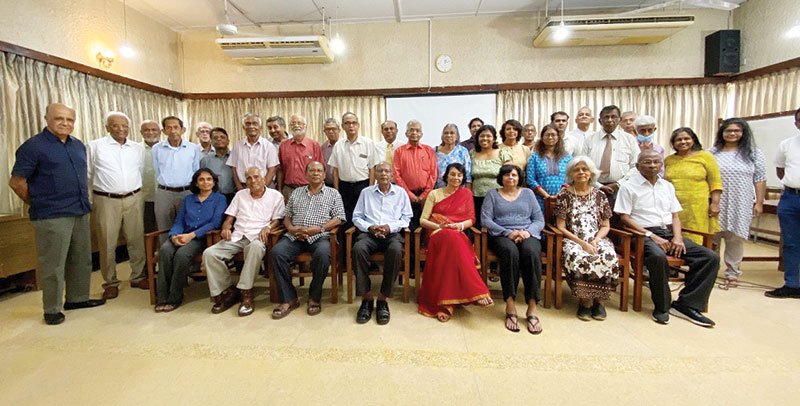
Last week I made mention of a gathering in Colombo to remember Kumar David, who passed away last October, as Comrade, Professor and Friend. The event was held on Saturday, April 5th, a day of double significance, first as the anniversary of the JVP insurrection on 5th April 1971, and now the occasion of the official welcome extended to visiting Indian Prime Narendra Modi by the still new JVP-NPP government. The venue was the Ecumenical Institute for Study and Dialogue (EISD) on Havelock Road, which has long been a forum for dialogues and discussions of topics ranging from religious ecumenism, Liberation Theology and Marxist politics. Those who gathered to remember Kumar were also drawn from many overlapping social, academic, professional and political circles that intersected Kumar’s life and work at multiple points. Temporally and collectively, the gathering spanned over six decades in the evolution of post-independence Sri Lanka – its politics, society and the economy.
Several spoke and recalled memories, and their contributions covered from what many of us have experienced as Sri Lankans from the early 1960s to the first two and a half decades of the 21st century. The task of moderating the discussion fell to Prof. Vijaya Kumar, Emeritus Professor of Chemistry at Peradeniya, who was a longtime friend of Kumar David at the university and a political comrade in the LSSP – especially in the Party’s educational and publication activities.
Vijaya Kumar recalled Kumar David’s contributions not only to Marxist politics but also to the popularization of Science that became a feature in several of KD’s weekly contributions to the Sunday Island and the Colombo Telegraph. Marshal Fernando, former and longtime Director of the EISD welcomed the participants and spoke of Kumar David’s many interactions with the Institute and his unflinching offer of support and advice to its activities. EISD’s current Director, Fr. Jayanath Panditharatne and his staff were extremely helpful.
Rohini David, Kumar’s wife of over 50 years, flew in specially for the occasion from Los Angeles and spoke glowingly of Kumar’s personal life as a husband and a father, and of his generosity for causes that he was committed to, not only political, but also, and more importantly, educational. An interesting nugget revealed by Rohini is the little known fact that Kumar David was actually baptized twice – possibly as a Roman Catholic on his father’s side, and as an Anglican on his mother’s side. Yet he grew to see an altogether different light in all of his adult life. Kumar’s father was Magistrate BGS David, and his maternal grandfather was a District Judge, James Joseph.
Kumar had an early introduction to politics as a result of his exposure to some of the political preparations for the Great Hartal of 1953. Kumar was 12 years old then, and the conduit was his step-father, Lloyd de Silva an LSSPer who was close to the Party’s frontline leaders. From a very young age, Kumar became familiar with all the leaders and intellectuals of the LSSP. Lloyd was known for his sharp wit and cutting polemics. One of my favourite lines is his characterization of Bala Tampoe as a “Lone Ranger in the Mass Movement.” Lloyd’s polemics may have rubbed on Kumar’s impressionable mind, but the more enduring effect came from Lloyd’s good collection of Marxist books that Kumar self-admittedly devoured as much as he could as a teenager and an undergraduate.
Electric Power and Politics
Early accounts of Kumar’s public persona came from Chris Ratnayake, Prof. Sivasegaram and Dr. K. Vigneswaran, all Kumar’s contemporaries at the Engineering Faculty that was then located in Colombo. From their university days in the early 1960s, until now, they have witnessed, been a part of and made their own contributions to politics and society in Sri Lanka. Chris, a former CEB and World Bank Electrical Engineer, was part of the Trotskyite LSSP nucleus in the Engineering Faculty, along with Bernard Wijedoru, Kumar David, Sivaguru Ganesan, MWW Dharmawardana, Wickramabahu Karunaratne and Chris Rodrigo. Of that group only Chris and MWW are alive now.
Chris gave an accurate outline of their political involvement as students, Kumar’s academic brilliance and his later roles as a Lecturer and Director of the CEB under the United Front Government. Chris also described Kumar’s later academic interest and professional expertise in the unbundling of power systems and opening them to the market. Even though he was a Marxist, or may be because of it, Kumar had a good understanding of the operation of the market forces in the electricity sector.
Chris also dealt at length on Sri Lanka’s divergent economic trajectories before and after 1977, and the current aftermath of the recent economic crisis. As someone who has worked with the World Bank in 81 countries and has had the experience of IMF bailout programs, Chris had both warning and advice in light of Sri Lanka’s current situation. No country, he said, has embarked on an economic growth trajectory by following standard IMF prescriptions, and he pointed out that countries like the Asian Tigers have prospered not by following the IMF programs but by charting their own pathways.
Prof. S. Sivasegaram and Dr. K. Vigneswaran graduated in 1964, one year after Kumar David, with first classes in Mechanical Engineering and Civil Engineering, respectively. Sivasegaram joined the academia like Kumar David, while Vigneswaran joined the Irrigation Department but was later drawn into the vortex of Tamil politics where he has been a voice of reason and a source for constructive alternatives. As Engineering students, they were both Federal Party supporters and were not aligned with Kumar’s left politics.
It was later at London Imperial College, Sivasegaram said, he got interested in Marxism and he credited Kumar as one of the people who introduced him to Marxism and to anti-Vietnam protests. But Kumar could not persuade Sivasegaram to be a Trotskyite. Sivasegaram has been a Maoist in politics and apart from his Engineering, he is also an accomplished poet in Tamil. Vigneswaran recalled Kumar’s political involvement as a Marxist in support of the right of self-determination of the Tamils and his accessibility to Tamil groups who were looking for support from the political left.
K. Ramathas and Lal Chandranath were students of Kumar David at Peradeniya, and both went on to become established professionals in the IT sector. Ramathas passionately recalled Kumar’s effectiveness as a teacher and described his personal debt of gratitude for helping him to get a lasting understanding of the concept and application of power system stability. This understanding has helped him deal with other systems, said Ramathas, even as he bemoaned the lack of understanding of system stability among young Engineers and their failure to properly explain and address recurrent power failures in Sri Lanka.
Left Politics without Power
The transition from Engineering to politics in the discussion was seamlessly handled by veterans of left politics, viz., Siritunga Jayasuriya, Piyal Rajakaruna and Dishan Dharmasena, and by Prof. Nirmal Dewasiri of the History Department at the University of Colombo. Siritunga, Piyal and Dishan spoke to the personal, intellectual and organizational aspects of Kumar David in the development of left politics after Kumar David, Vasudeva Nanayakkara and Bahu were no longer associated with the LSSP. Dewasiri reflected on the role of the intellectuals in left political parties and the lost to the left movement as a whole arising from the resignation or expulsion of intellectuals from left political organizations.
While Kumar David’s academic and professional pre-occupation was electric power, pursuing power for the sake of power was not the essence of his politics. That has been the case with Bahu and Sivasegaram as well. They naturally had a teaching or educational role in politics, but they shared another dimension that is universally common to Left politics. Leszek Kolakowski, the Polish Marxist who later became the most celebrated Marxist renegade, has opined that insofar as leftists are generally ahead of their times in advocating fundamental social change and promoting ideas that do not resonate with much of the population, they are unlikely to win power through electoral means.
Yet opposition politics predicated on exposing and decrying everything that is wrong with the system and projecting to change the system is fundamentally the most moral position that one can take in politics. So much so it is worth pursuing even without the prospect of power, as Hector Abhayavardhana wrote in his obituaries for LSSP leaders like NM Perera and Colvin R de Silva. By that token, the coalition politics of the 1960s could be seen as privileging a shared parliamentary path to power while dismissing as doctrinaire the insistence on a sole revolutionary path to power.
The two perspectives clashed head on and splintered the LSSP at its historic 1964 Conference. Kumar David and Lal Wijenayake were the youngest members at that conference, and the political genesis of Kumar David and others at the Engineering faculty that Chris Ratnayake outlined was essentially post-coalition politics. In later years, Vasudeva Nanayakkara, Bahu and Kumar David set about creating a left-opposition (Vama) tendency within the LSSP.
This was considered a superior alternative to breaking away from the Party that had been the experience of 1964. Kumar David may have instinctively appreciated the primacy of the overall system stability even if individual components were getting to be unstable! But their internal efforts were stalled, and they were systematically expelled from the Party one by one. Kumar David recounted these developments in the obituary he wrote for Bahu.
As I wrote last week, after 1977 and with the presidential system in place, the hitherto left political parties and organizations generally allied themselves with one or the other of the three main political alliances led by the SLFP, the SLPP and even the UNP. A cluster of them gravitated to the NPP that has been set up by the JVP under the leadership of Anura Kumara Dissanayake. Kumar David supported the new JVP/NPP initiative and was optimistic about its prospects. He wrote positively about them in his weekly columns in the Sunday Island and the Colombo Telegraph.
The Social Circles of Politics
Sometime in late 2006, Rohan Edrisinha introduced Kumar and me to Rajpal Abeynayake, who was then the Editor of the Sunday Observer, for the purpose of writing weekly columns for the Paper. Bahu was already writing for the Sunday Observer and for almost an year, Bahu, Kumar and I were Sunday Island columnists, courtesy of Rajpal Abeynayake. In 2007, Prof. Vijaya Kumar introduced us to Manik de Silva, already the doyen of Sri Lanka’s English medium editors, and Kumar and I started writing for the Sunday Island edited by Manik. It has been non-stop weekly writing a full 18 years. For a number of years, we have also been publishing modified versions of our articles in the Colombo Telegraph, the online journal edited by the inimitable Uvindu Kurukulasuriya.
Writing mainstream rekindled old friendships and created new ones. It was gratifying to see many of them show up at the celebration of life for Kumar. That included Rajpal Abeynayake, Bunchy Rahuman, Gamini Kulatunga, Ranjith Galappatti, Tissa Jayatilaka, NG (Tanky) Wickremeratne, and Manik de Silva. Vijaya Chandrasoma, who unfortunately could not attend the meeting, was particularly supportive of the event along with Tanky and Ramathas. Tissa and Manik spoke at the event and shared their memories of Kumar.
Dr. Santhushya Fernando of the Colombo Medical Faculty provided organizational support and created two superb video montages of Kumar’s life in pictures to background theme songs by Nat King Cole and Frank Sinatra. Manoj Rathnayake produced a Video Recording of the event.
In a quirky coincidence, five of those who attended the event, viz. Manik de Silva, Vijaya Kumar, Chris Ratnayake, S. Sivasegaram and K. Vigneswaran were all classmates at Royal College. On a personal note, I have been associated with every one of them in one way or another. Chris and I were also Engineers at the Hantana Housing Development in the early 1980s, for which the late Suren Wickremesinghe and his wife Tanya were the Architects. And Suren was in the same Royal College class as the other five mentioned here.
In the last article he wrote before his passing, Kumar David congratulated Anura Kumara Dissanayake for his magnificent political achievement and expressed cautious optimism for the prospects under an NPP government. Many in the new government followed Kumar David’s articles and opinions and were keen to participate in the celebration of life that was organized for him. That was not going to be possible anyway with the visit of Prime Minister Modi falling on the same day. Even so, Prof. Sunil Servi, Minister of Buddha Sasana, and Religious and Cultural Affairs, was graciously present at the event and expressed his appreciation of Kumar David’s contributions to Sri Lankan politics and society.
by Rajan Philips
Features
53 Years of HARTI- Looking Back and Looking Ahead
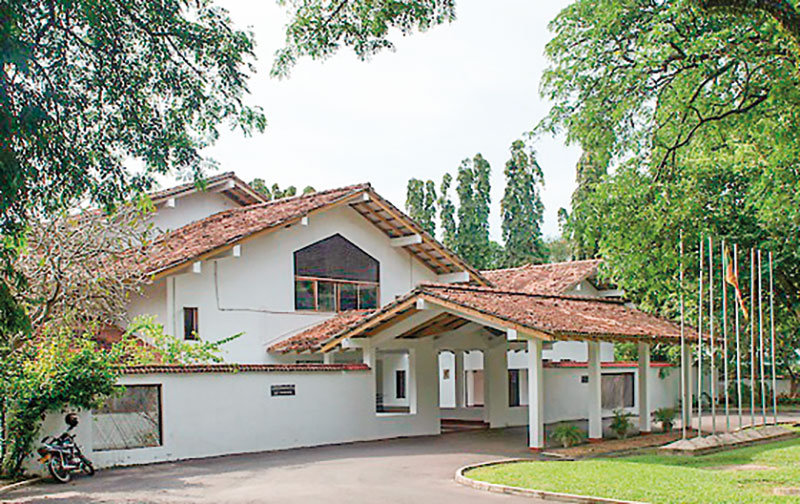
C. Narayanasuwami, the first Director of the then Agrarian Research and Training Institute (ARTI).
I am delighted to be associated with the fifty third anniversary celebrations of HARTI. I cherish pleasant memories of the relentless efforts made as the First Director to establish, incorporate, develop, direct, and manage a nascent institute in the 1970s amidst many challenges. The seven-year period as Director remains as the most formidable and rewarding period in my career as a development professional. I have been fortunate to have had a continuing relationship with HARTI over the last five decades. It is rarely that one who played a significant role in the establishment and growth of an institution gets an opportunity to maintain the links throughout his lifetime and provide messages on the completion of its fifth (I was still the director then), the 15th, 50th and 53rd anniversaries.
I had occasion also to acknowledge the contribution of the Institute on its 46th year when I released my book, ‘Managing Development: People, Policies and Institutions’ using HARTI auditorium and facilities, with the able support of the then director and staff who made the event memorable. The book contains a special chapter on HARTI.
On HARTI’s 15th anniversary I was called upon to offer some thoughts on the Institute’s future operations. The following were some of my observations then, “ARTI has graduated from its stage of infancy to adolescence….Looking back it gives me great satisfaction to observe the vast strides it has made in developing itself into a dynamic multidisciplinary research institution with a complement of qualified and trained staff. The significant progress achieved in new areas such as marketing and food policy, data processing, statistical consultancies, information dissemination and irrigation management, highlights the relevance and validity of the scope and objectives originally conceived and implemented”.
It may be prudent to review whether the recommendations contained in that message, specifically (a) the preparation of a catalogue of research findings accepted for implementation partially or fully during policy formulation, (b) the relevance and usefulness of information services and market research activities in enhancing farmer income, and (c) the extent to which the concept of interdisciplinary research- a judicious blend of socio-economic and technical research considered vital for problem-oriented studies- was applied to seek solutions to problems in the agricultural sector.
The thoughts expressed on the 15th anniversary also encompassed some significant management concerns, specifically, the need to study the institutional capabilities of implementing agencies, including the ‘human factor’ that influenced development, and a critical review of leadership patterns, management styles, motivational aspects, and behavioural and attitudinal factors that were considered vital to improve performance of agrarian enterprises.
A review of HARTI’s current operational processes confirm that farmer-based and policy-based studies are given greater attention, as for example, providing market information service for the benefit of producers, and undertaking credit, microfinance, and marketing studies to support policy changes.
The changes introduced over the years which modified the original discipline-based research units into more functional divisions such as agricultural policy and project evaluation division, environmental and water resources management division, and agricultural resource management division, clearly signified the growing importance attached to functional, action-oriented research in preference to the originally conceived narrowly focused discipline-based research activities.
HARTI has firmly established its place as a centre of excellence in socio-economic research and training with a mature staff base. It is pertinent at this juncture to determine whether the progress of HARTI’s operations was consistently and uniformly assessed as successful over the last five decades.
Anecdotal evidence and transient observations suggest that there were ups and downs in performance standards over the last couple of decades due to a variety of factors, not excluding political and administrative interventions, that downplayed the significance of socio-economic research. The success of HARTI’s operations, including the impact of policy-based studies, should be judged on the basis of improved legislation to establish a more structured socio-economic policy framework for agrarian development.
Looking Ahead
Fifty-three years in the life of an institution is substantial and significant enough to review, reflect and evaluate successes and shortcomings. Agrarian landscapes have changed over the last few decades and national and global trends in agriculture have seen radical transformation. Under these circumstances, such a review and reflection would provide the basis for improving organisational structures for agricultural institutions such as the Paddy Marketing Board, development of well-conceived food security plans, and above all, carefully orchestrated interventions to improve farmer income.
New opportunities have arisen consequent to the recent changes in the political horizon which further validates the role of HARTI. HARTI was born at a time when Land Reform and Agricultural Productivity were given pride of place in the development programs of the then government. The Paddy Lands Act provided for the emancipation of the farming community but recent events have proven that the implementation of the Paddy Lands Act has to be re-looked at in the context of agricultural marketing, agricultural productivity and income generation for the farming community.
Farmers have been at the mercy of millers and the price of paddy has been manipulated by an oligopoly of millers. This needs change and greater flexibility must be exercised to fix a guaranteed scale of prices that adjust to varying market situations, and provide adequate storage and milling facilities to ensure that there is no price manipulation. It is time that the Paddy Lands Act is amended to provide for greater flexibility in the provision of milling, storage and marketing services.
The need for restructuring small and medium scale enterprises (SMEs) recently announced by the government warrants greater inputs from HARTI to study the structure, institutional impediments and managerial constraints that inflict heavy damages leading to losses in profitability and organisational efficiency of SMEs.
Similarly, HARTI should look at the operational efficiency of the cooperative societies and assess the inputs required to make them more viable agrarian institutions at the rural level. A compact research exercise could unearth inefficiencies that require remedial intervention.
With heightened priority accorded to poverty alleviation and rural development by the current government, HARTI should be in the forefront to initiate case studies on a country wide platform, perhaps selecting areas on a zonal basis, to determine applicable modes of intervention that would help alleviate poverty.
The objective should be to work with implementing line agencies to identify structural and institutional weaknesses that hamper implementation of poverty reduction and rural development policies and programs.
The role played in disseminating marketing information has had considerable success in keeping the farming community informed of pricing structures. This should be further expanded to identify simple agricultural marketing practices that contribute to better pricing and income distribution.
HARTI should consider setting up a small management unit to provide inputs for management of small-scale agrarian enterprises, including the setting up of monitoring and evaluation programs, to regularly monitor and evaluate implementation performance and provide advisory support.
Research and training must get high level endorsement
to ensure that agrarian policies and programs constitute integral components of the agricultural development framework. This would necessitate a role for HARTI in central planning bodies to propose, consider and align research priorities in line with critical agricultural needs.
There is a felt need to establish links with universities and co-opt university staff to play a role in HARTI research and training activities-this was done during the initial seven-year period. These linkages would help HARTI to undertake evaluative studies jointly to assess impacts of agrarian/agricultural projects and disseminate lessons learned for improving the planning and execution of future projects in the different sectors.
In the overall analysis, the usefulness of HARTI remains in articulating that research and analysis are crucial to the success of implementation of agrarian policies and programs.
In conclusion, let us congratulate the architects and the dynamic management teams and staff that supported the remarkable growth of HARTI which today looks forward to injecting greater dynamism to build a robust institution that would gear itself to meeting the challenges of a new era of diversified and self-reliant agrarian society. As the first director of the Institute, it is my wish that it should grow from strength to strength to maintain its objectivity and produce evidence-based studies that would help toward better policies and implementation structures for rural transformation.
Features
Keynote Speech at the Launch of The Ceylon Journal, by Rohan Pethiyagoda
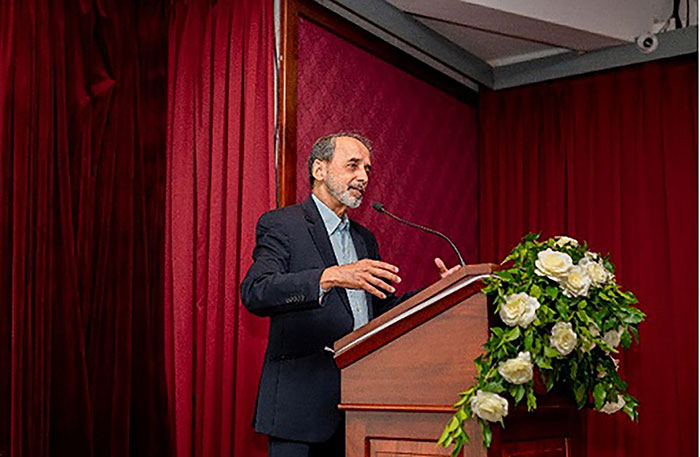
“How Rubber Shaped our Political Philosophy”
The Ceylon Journal was launched last August. Its first issue is already out of print. Only a handful of the second issue covering new perspectives of history, art, law, politics, folklore, and many other facets of Sri Lanka is available. To reserve your very own copy priced Rs. 2000 call on 0725830728.
Congratulations, Avishka [Senewiratne]. I am so proud of what you have done. Especially, Ladies and Gentlemen, to see and hear all of us stand up and actually sing the National Anthem was such a pleasure. Too often on occasions like this, the anthem is played, and no one sings. And we sang so beautifully this evening that it brought tears to my eyes. It is not often we get to think patriotic thoughts in Sri Lanka nowadays: this evening was a refreshing exception.
I’m never very sure what to say on an occasion like this, in which we celebrate history, especially given that I am a scientist and not a historian. It poses something of a challenge for me. Although we are often told that we must study history because it repeats itself, I don’t believe it ever does. But history certainly informs us: articles such as those in The Ceylon Journal, of which I read an advance copy, help us understand the context of our past and how it explains our present.
I want to take an example and explain what I am on about. I’m going to talk about rubber. Yes rubber, as in ‘eraser’, and how it crafted our national political identity, helping, even now seven decades later, to make ‘capitalism’ a pejorative.
As I think you know already, rubber came into general use in the middle of the 19th century. Charles Macintosh invented the raincoat in 1824 by placing a thin sheet of rubber between two sheets of fabric and pressing them together. That invention transformed many things, not least warfare. Just think of Napoleon’s invasion of Russia in the winter of 1812. His troops did that without any kind of waterproof clothing. Some 200,000 of them perished, not from bullets but from hypothermia. Waterproof raincoats could have saved thousands of lives. Not long after rubber came to be used for waterproofing, we saw the first undersea telegraph cable connecting Europe to North America being laid in the 1850s. When the American civil war broke out in 1860, demand for rubber increased yet further: the troops needed raincoats and other items made from this miracle material.
At that time rubber, used to be collected from the wild in the province of Pará in Northern Brazil, across which the Amazon drains into the Atlantic. In 1866, steamers began plying thousands of kilometres upriver, to return with cargoes of rubber harvested from the rainforest. Soon, the wild trees were being tapped to exhaustion and the sustainability of supply became doubtful.
Meanwhile, England was at the zenith of its colonial power, and colonial strategists thought rather like corporate strategists do today. The director of the Kew Gardens at the time, Joseph Hooker, felt there might be one day be a greater potential for rubber. He decided to look into the possibility of cultivating the rubber tree, Hevea brasiliensis, in Britain’s Asian colonies. So, he dispatched a young man called Henry Wickham to the Amazon to try to secure some seeds. In 1876, Wickham returned to Kew with 70,000 rubber seeds. These were planted out in hothouses in Kew and by the end of that year, almost 2000 of them had germinated.
These were dispatched to Ceylon, only a few weeks’ voyage away now, thanks to steamships and the Suez Canal. The director of the Peradeniya Botanic Garden at the time was George Henry Kendrick Thwaites, a brilliant systematic botanist and horticulturalist. Thwaites received the seedlings and had to decide where to plant them. He read the available literature—remember, this was 1876: there was no internet—and managed to piece together a model of the climatic conditions in the region of the Amazonian rainforest to which rubber was native. He decided that the plants would need an elevation of less than 300 metres and a minimum annual rainfall of at least 2000mm. In other words, the most suitable region for rubber would be an arc about 30 kilometres wide, extending roughly from Ambalangoda to Matale. Despite his never having seen a rubber plant until then, astonishingly, he got it exactly right.
Thwaites settled on a site in the middle of the arc, at Henarathgoda near Gampaha. That became the world’s first rubber nursery: the first successful cultivation of this tree outside Brazil. The trees grew well and, eight years later, came into seed. Henry Trimen, Thwaites’ successor, used the seeds to establish an experimental plantation near Polgahawela and also shared seeds with the Singapore Botanic Garden. Those would later become the foundation of the great Malaysian rubber industry.
But up to that time, Sri Lanka’s rubber plantation remained a solution looking for a problem. Then, in 1888, the problem arrived, and from a completely unexpected quarter: John Dunlop invented the pneumatic tire. Soon, bicycles came to be fitted with air-filled tires, followed by motorcars. In 1900, the US produced just 5,000 motorcars; by 1915, production had risen to half a million. The great rubber boom had begun.
Meanwhile, the colonial administration in Ceylon had invited investors to buy land and start cultivating rubber to feed the growing international demand. But by the early 1890s, three unusual things had happened. First, with the collapse of the coffee industry in the mid-1870s, many British investors had been bankrupted. Those who survived had to divert all their available capital into transitioning their failing coffee plantations into tea. They were understandably averse to risk. As a result, the British showed little interest in this strange tree called rubber that had been bought from Brazil.
Second, a native Sri Lankan middle class had by then emerged. The Colebrooke-Cameron reforms had led to the establishment of the Royal academy, later Royal College, by 1835. Other great schools followed in quick succession. From the middle of the 19th century, it was possible for Sri Lankans to get an education and get employment in government service, become professionals, doctors, lawyers, engineers, civil servants, clerks, and so on. And so, by the 1890s, a solid native middle class had emerged. The feature that defines a middle class, of course, is savings, and these savings now came to be translated into the capital that founded the rubber industry.
Third, the British had by then established a rail and road network and created the legal and commercial institutions for managing credit and doing business—institutions like banks, financial services, contract law and laws that regulated bankruptcy. They had made the rules, but by now, Sri Lankans had learned to play the game. And so, it came to be that Sri Lankans came to own a substantial part of the rubber-plantation industry very early in the game. By 1911, almost 200,000 acres of rubber had been planted and world demand was growing exponentially.
In just one generation, investors in rubber were reaping eye-watering returns that in today’s money would equate to Rs 3.6 million per acre per year. It was these people who, together with the coconut barons, came to own the grand mansions that adorn the poshest roads in Cinnamon Gardens: Ward Place, Rosmead Place, Barnes Place, Horton Place, and so on. There was an astonishingly rapid creation of indigenous wealth. By 1911, the tonnage at shipping calling in Sri Lankan ports—Colombo and Trincomalee—exceeded nine million tons, making them collectively the third busiest in the British Empire and the seventh busiest in the world. By comparison, the busiest port in Europe is now Rotterdam, which ranks tenth in the world.
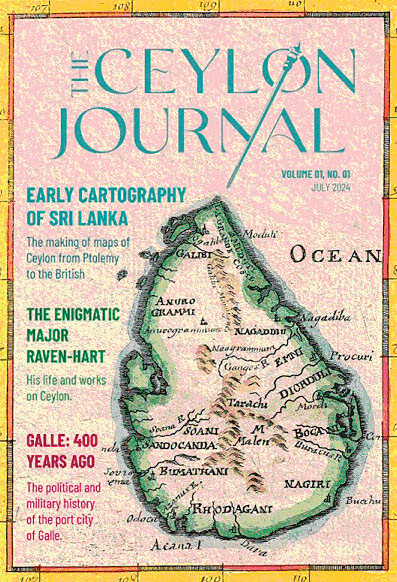 We often blame politicians for things that go wrong in our country and God knows they are responsible for most of it. But unfortunately for us, the first six years of independence, from 1948 to 1954, were really unlucky years for Sri Lanka. As if successive failed monsoons and falling rice crops weren’t bad enough, along came the Korean war. In the meantime, the Sri Lankan people had got used to the idea of food rations during the war and they wanted rations to be continued as free handouts. Those demands climaxed in the ‘Hartal’ of 1953, a general strike demanding something for nothing. Politicians were being forced to keep the promises they had made when before independence, that they would deliver greater prosperity than under the British.
We often blame politicians for things that go wrong in our country and God knows they are responsible for most of it. But unfortunately for us, the first six years of independence, from 1948 to 1954, were really unlucky years for Sri Lanka. As if successive failed monsoons and falling rice crops weren’t bad enough, along came the Korean war. In the meantime, the Sri Lankan people had got used to the idea of food rations during the war and they wanted rations to be continued as free handouts. Those demands climaxed in the ‘Hartal’ of 1953, a general strike demanding something for nothing. Politicians were being forced to keep the promises they had made when before independence, that they would deliver greater prosperity than under the British.
So, by 1949, D. S. Senanayake was forced to devalue the rupee, leading to rapid price inflation. Thankfully we didn’t have significant foreign debt then, or we might have had to declare insolvency much earlier than we finally did, in 2022. And then, because of failing paddy harvests, we were forced to buy rice
from China, which was in turn buying our rubber. But as luck would have it, China entered the Korean war, causing the UN, at the behest of the US, to embargo rubber exports to China.
This placed the D. S. Senanayake and John Kotelawala governments in an impossible predicament. There was a rice shortage; people were demanding free rice, and without rubber exports, there was no foreign exchange with which to buy rice. Kotelawala flew to Washington, D.C., to meet with President Eisenhower and plead for either an exemption from the embargo or else, for the US to buy our rubber. Despite Sri Lanka having provided rubber to the Allies at concessionary prices during the war and having supported the Allies, Eisenhower refused. British and American memories were short indeed. In India, Mahatma Gandhi and the Congress Party had chosen the moment, in August 1942 when Japan invaded Southeast Asia and were poised to invade Bengal, to demand that the British quit India, threatening in the alternative that they would throw their lot in with the Japanese. The Sri Lankan government, by contrast, had stood solidly by the Allies. But now, those same allies stabbed the fledgling nation in the chest. Gratitude, it seemed, was a concept alien to the West.
In these circumstances, Sri Lanka had no choice but to break the UN embargo and enter into a rice-for-rubber barter agreement with China. This resulted not only in the US suspending aid and the supply of agricultural chemicals to Sri Lanka, but also invoking the Battle Act and placing restrictions on US and UK ships calling at the island’s ports.
Understandably, by 1948, Sri Lankans entertained a strong disdain for colonialism. With the Cold War now under way, the USSR and China did all they could to split countries like Sri Lana away not just from their erstwhile colonial masters but also the capitalist system. If any doubt persisted in the minds of Sri Lankan politicians, Western sanctions put an end to that. The country fell into the warm embrace of the communist powers. China and the USSR were quick to fill the void left by the West, and especially in the 1950s, there was good reason to believe that the communist system was working. The Soviet economy was seeing unprecedented growth, and that decade saw them producing hydrogen bombs and putting the first satellite, dog and man in space.
As a consequence of the West’s perfidy in the early 1950s, ‘Capitalism’ continues to have pejorative connotations in Sri Lanka to this day. And it resulted in us becoming more insular, more inward looking, and anxious to assert our nationalism even when it cost us dearly.
Soon, we abolished the use of English, and we nationalized Western oil companies and the plantations. None of these things did us the slightest bit of good. We even changed the name of the country in English from Ceylon to Sri Lanka. Most countries in the world have an international name in addition to the name they call themselves. Sri Lanka had been ‘Lanka’ in Sinhala throughout the colonial period, even as its name had been Ceylon in English. The Japanese don’t call themselves Japan in their own language, neither do the Germans call themselves Germany. These are international names for Nihon and Deutschland, just like Baharat or Hindustan is what Indians call India. But we insisted that little Sri Lanka will assert itself and insist what the world would call us, the classic symptom of a massive inferiority complex. While countries like Singapore built on the brand value of their colonial names, we erased ours from the books. Now, no one knows where Ceylon tea or Ceylon cinnamon comes from.
Singapore is itself a British name: it should be Sinha Pura, the Lion City, a Sanskrit name. But Singapore values its bottom line more than its commitment to terminological exactitude. Even the name of its first British governor, Sir Stamford Raffles, has become a valued national brand. But here in Sri Lanka, rather than build on our colonial heritage, not the least liberal values the British engendered in us, together with democracy and a moderately regulated economy, we have chosen to deny it and seek to expunge it from our memory. We rejected the good values of the West along with the bad: like courtesy, queuing, and the idea that corruption is wrong.
We have stopped fighting for the dignity of our land, and I hope that as you read the articles in The Ceylon Journal that are published in the future, we will be reminded time and time again of the beautiful heritage of our country and how we can once again find it in ourselves to be proud of this wonderful land.
-

 Business7 days ago
Business7 days agoColombo Coffee wins coveted management awards
-

 News2 days ago
News2 days agoSuspect injured in police shooting hospitalised
-

 Features3 days ago
Features3 days agoRobbers and Wreckers
-

 Features5 days ago
Features5 days agoSri Lanka’s Foreign Policy amid Geopolitical Transformations: 1990-2024 – Part III
-

 Midweek Review5 days ago
Midweek Review5 days agoInequality is killing the Middle Class
-

 Features7 days ago
Features7 days agoSri Lanka’s Foreign Policy amid Geopolitical Transformations: 1990-2024 – Part I
-

 Business2 days ago
Business2 days agoSanjiv Hulugalle appointed CEO and General Manager of Cinnamon Life at City of Dreams Sri Lanka
-

 Features6 days ago
Features6 days agoA brighter future …

